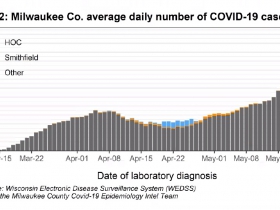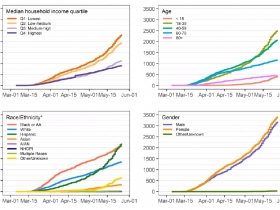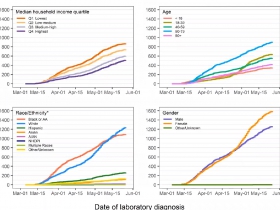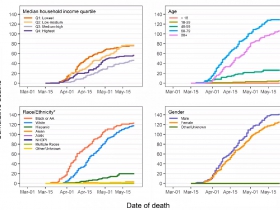Hispanics Now Have Greatest Number of COVID-19 Cases in Milwaukee
Also, county's poorest are more than 2.5 times as likely to contract COVID-19.
There are more than twice as many African Americans as there are Hispanics and Latinos in Milwaukee, but the latter group now has a greater number of COVID-19 cases. The change marks a turning point from when the disease was disproportionately affecting the city’s black community.
As of late March, 70 percent of those with the disease identified as black. That number is now 35 percent (1,968 cases), while members of the Hispanic community account for 37 percent (2,091) of the 5,740 confirmed COVID-19 cases in the city. Both figures would likely be higher if the city had complete data, but there is no racial data in 15 percent of cases.
The shift comes as the south side of the city, particularly the 65 percent Hispanic or Latino 53215 ZIP code, has seen the greatest number of new cases for over a month.
What’s driving the new cases?
“Perhaps the higher burden of disease in our Hispanic community is due to the high percentage of essential workers,” said Dr. Ben Weston, director of medical services for Milwaukee County, during a media briefing Thursday. “Jobs that require many people to leave the home and interact with the public.”
“Some of this is an artifact of these employer-related infections,” said Milwaukee Health Commissioner Jeanette Kowalik last week, promising a formal report was being produced.
The Milwaukee area has seen a number of outbreaks at places of employment, including Cargill in the Menomonee Valley and Smithfield Foods in Cudahy. Food processing plants have historically employed a large number of Hispanics or Latinos with entry-level skillsets who live in the city.
The report also shows that the disease is most prevalent in those with the lowest incomes. “The median income data continues to demonstrate that the lowest income quartiles have the greatest amount of COVID-19 disease and the greatest rate,” said Greenfield public health officer Darren Rausch in presenting the report Thursday.
The poorest Milwaukeeans are more than 2.5 times as likely to contract COVID-19 than other income groups, according to the latest Milwaukee County case data.
Ian Bautista, senior director of civic engagement at the Greater Milwaukee Foundation, noted in April when the 53215 outbreak was first starting that the greater amount of intergenerational households in the city’s minority communities could also contribute to faster spread.
Data shared by Rausch on Thursday showed the age group with the greatest number of new cases is individuals aged 18 to 39. “That’s particularly worrisome because that’s different than what we have seen in the past,” he said.
Deaths have a different distribution.
In Milwaukee, 40 percent of residents are black, 37 percent white, 17.3 percent Hispanic or Latino and 3.5 percent Asian according to the 2010 census.
But the race or ethnicity of those that died does not reflect either the case distribution or population distribution. The Milwaukee Health Department reports that 63 percent of people that have died have been black, 26 percent white and 10 percent Hispanic.
Data shared by Rausch showed that countywide, the number of deaths in both the white and black communities is nearly equal. But that would still represent a disproportionate share for the black community. Approximately 26 percent of county residents, city included, identify as black.
Statewide deaths have occurred most prominently in those over the age of 70, despite the number of cases being more evenly distributed. Over 70 percent of those that have died have been 70 or older.
None of the public dashboards include the ability to filter the age of those with cases by race or ethnicity.
Hospitalization data tells a different story than either race, ethnicity, age or income. The report shows that cumulative hospitalizations have been greatest in the white community since May 15th, eclipsing African Americans.
Hospitalization rates are more evenly distributed than deaths in terms of age, with 18-to-39-year-olds having the second greatest total number of hospitalizations behind those aged 60 to 79. Hospitalizations by income quartile are more evenly distributed than the number of cases by the same distribution. But the report does provide data as a percentage of cases, instead using a total number.
And despite representing fewer cases, both blacks and whites have hospitalization totals more than five times that of the county’s Hispanic community. State health officials previously said hospitalizations can lag three to five weeks behind confirmed cases.
For more information on what neighborhoods are most affected, and how that has changed over time, see our coverage from Tuesday.
Epidemiological Report Charts
If you think stories like this are important, become a member of Urban Milwaukee and help support real, independent journalism. Plus you get some cool added benefits.
More about the Coronavirus Pandemic
- Governors Tony Evers, JB Pritzker, Tim Walz, and Gretchen Whitmer Issue a Joint Statement Concerning Reports that Donald Trump Gave Russian Dictator Putin American COVID-19 Supplies - Gov. Tony Evers - Oct 11th, 2024
- MHD Release: Milwaukee Health Department Launches COVID-19 Wastewater Testing Dashboard - City of Milwaukee Health Department - Jan 23rd, 2024
- Milwaukee County Announces New Policies Related to COVID-19 Pandemic - David Crowley - May 9th, 2023
- DHS Details End of Emergency COVID-19 Response - Wisconsin Department of Health Services - Apr 26th, 2023
- Milwaukee Health Department Announces Upcoming Changes to COVID-19 Services - City of Milwaukee Health Department - Mar 17th, 2023
- Fitzgerald Applauds Passage of COVID-19 Origin Act - U.S. Rep. Scott Fitzgerald - Mar 10th, 2023
- DHS Expands Free COVID-19 Testing Program - Wisconsin Department of Health Services - Feb 10th, 2023
- MKE County: COVID-19 Hospitalizations Rising - Graham Kilmer - Jan 16th, 2023
- Not Enough Getting Bivalent Booster Shots, State Health Officials Warn - Gaby Vinick - Dec 26th, 2022
- Nearly All Wisconsinites Age 6 Months and Older Now Eligible for Updated COVID-19 Vaccine - Wisconsin Department of Health Services - Dec 15th, 2022
Read more about Coronavirus Pandemic here


























